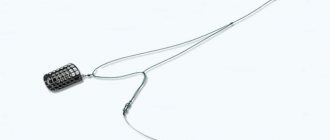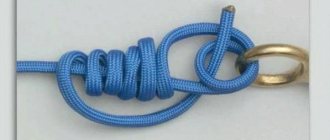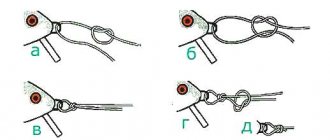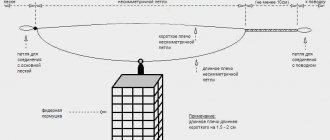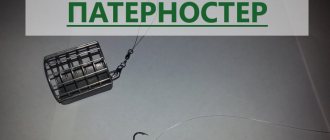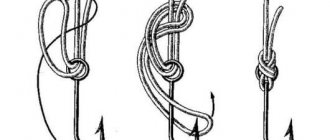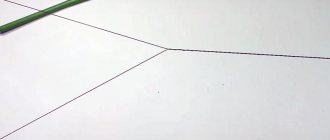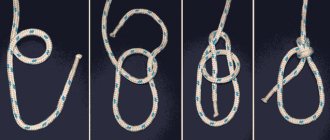What is a self-tightening knot
A feature of any self-tightening knot is its ability to tie tightly under load (the greater the force, the stronger the knot). Such loops are widely used in fishing, especially when bottom fishing is planned using a capacious reel to tie the fishing line to the connector when installing the hook.
Knitting with a tightening effect is used both to connect the fishing line to the spool and to attach the hook to the string. To untie the knot, you only need to remove the force from the fastening.
Application
People began tying knots from ancient times. At the same time, the units received their greatest use in the navy. And one of the worthy places in the classification of marine ties is occupied by self-tightening knots - the simplest and easiest to perform.
Self-tightening knots are actively used in mountaineering and maritime affairs, but they will also be useful in everyday life.
For example, this link will help:
- on vacation: hang a hammock, attach a canopy;
- in everyday life: stretch a clothesline, build a drying rack for herbs;
- on the street: tie the pet to a support; cows and goats are also tied when walking;
- when fishing: secure the boat, tie the fishing line.
- when making handicrafts: tie a bracelet, jewelry.
The main purpose of a self-tightening tie is to secure a rope on a stationary basis or to be able to secure a load on a cable with the ability to move it along the cable.
Advantages and disadvantages of knots with tightening
A self-tightening line loop significantly simplifies fishing, which is reflected in the following points:
- You can knit knots without additional equipment, even without initial skills in this matter.
- Provided that constant tension is maintained during the process of forming the loop, slipping during catching of the running end is excluded - the knot is not able to unravel on its own.
The disadvantage of such fastening is the need to ensure a constant load on the rod. If the force is applied jerkily, the tightening may become loose and the loop may come undone.
Photo tips on how to tie fishing line to a reel
Note!
How to tie a fishing line to a reel - methods, tips on how to tie correctly and an overview of the most reliable knots (85 photos and videos)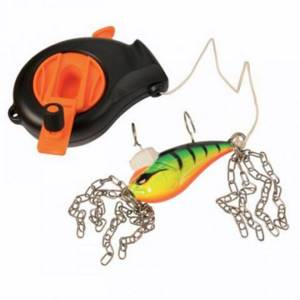
Cuts for wobblers and spinners - how to make a simple homemade cut. 110 photos and videos of practical tips
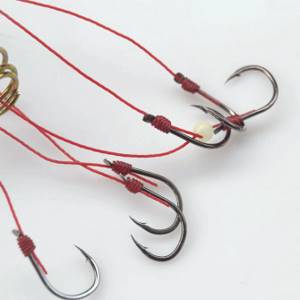
How to tie a hook to a fishing line - advice from professionals and the best patterns for beginners (115 photos and videos)
Read here Donkey equipment - varieties, main elements, installation and principle of operation (145 photos and videos)
Help the project, share on social networks 

0
Types of self-tightening knots with knitting patterns
There are several main types of self-tightening loop knot. Below is a detailed description of the three basic puffs.
Bovine
Its feature is the rapid formation of a loop in just 3 steps:
- Wrap a rope or fishing line around the support, making one turn.
- A simple loop is formed by turning around the rope, the running end is wrapped around the support in the opposite direction.
- A tightening knot made of fishing line or rope is obtained by pulling the running end between the support and the thread, tightening the created loop.
Even an inexperienced fisherman can tie such a self-tightening knot.
With half bayonet
To make a self-tightening loop on a fishing line with a half-bayonet, you will have to work hard, stock up on time and patience. A certain sequence of actions is provided:
- Using the running end of the thread, an open loop is formed around the load or bobbin of the reel.
- Circle the root end, bringing the line into a closed loop.
- The running end of the cable is wrapped three or four times around the loop from the front side, then passing it into the main loop.
- Make a tight knot by forming two half-pins around the load, making sure that they are placed on the side of the applied force.
Your question to expert
Luka Strelnikov
Professional fisherman with extensive experience
Ask a Question
In order for a tightening knot made of fishing line with a half bayonet to have high reliability and be equal in strength to the similar characteristics of the lace, rope or fishing line from which it is knitted, it is important to meet a number of conditions. When tying a loop, it is slightly shifted from the middle of the load. The running end of the rope, which comes out of the loop, is pulled in the direction of the force applied to the spinning rod.
Blind loop
When tying a self-tightening knot of this type, adhere to a number of rules:
- forming a loop begins by connecting a rope or fishing line into a simple cow knot;
- the main and running ends are brought into one line;
- pull both threads together at the same time, forming a tight knot.
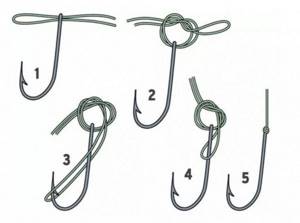
A blind loop is a type of self-tightening knot for fishing line on a reel, otherwise called a tag knot. It is convenient to use not only in fishing, but also for tying objects with holes (rings, washers), when tying a leash on an animal.
| Rice. 49. Retractable bayonet |
"Constrictor"
(Fig. 50). “Boa constrictor” is the zoological name for boa constrictor in Latin. Snakes such as the boa constrictor, python and anaconda are known to kill their prey by constricting them in three loops of their body. The knot, known throughout the world by this name, is one of the most tightly tightened knots.
At the same time, it is considered one of the most difficult knots to untie. As a rule, it is not even untied; it serves only once. The “constrictor” tightens well if it is tied to round objects that do not have sharp corners; in this case it is irreplaceable.
This is a very useful and important unit for our everyday life. With its help, you can, for example, tie a bag very tightly, the valve of a soccer ball chamber, compress a leaking rubber hose, tighten a rolled-up carpet, bag, cotton blanket, tie the hand of a hooligan; apply a tourniquet to the wounded limb and much more.
With this amazing knot you can lift the carcass of a dead bear without damaging its skin. To do this, you need to take a drek or a short strong stick, put it into the animal’s mouth, by its fangs, and tie the mouth with the stick with a “constrictor”.
Attach its ends to the hook or weight pendant. Professional riggers use a “constrictor” to apply temporary marks to the steel cable in those places where it needs to be cut. By doing this, they prevent the cable from unraveling before permanent wire marks are applied.
| Fig. 50. "Constrictor" |
Double constrictor
(Fig. 51). Although this knot is more complex than the one just described, it tightens even more. It, like the single “constrictor”, is considered an indispensable tightening knot in everyday life.
Rice. 51. Double “constrictor”
Python knot
(Fig. 52). Just as a python is almost no different from a boa constrictor, so this knot has no special differences from a “constrictor”. They are similar in principle. The Python knot is applicable for the same cases as the “constrictor”.
In addition, it can be very useful for connecting two transverse slats (Fig. 52, b). Their connection using this knot will be much stronger than with nails.
For example, a python knot is convenient for tying the wooden slats of a kite. It can be used when constructing a wicker fence, when one rope needs to be tied to another at a right angle.
Rice. 52. Python knot:
Miner's junction (Fig. 53). This unit is simple, original and reliable. It holds up well under constant load. Apparently, it got its name due to the fact that it was used in the mines. And although it is not considered a maritime knot, it can be successfully used both on land and at sea.
Picket node
(Fig. 54). This knot is somewhat reminiscent of a bleached knot, although its diagram is different. It can be used for the same purposes. Apparently, it got its name from the fact that they used it to tie a cable to the risers when making pickets.
| Rice. 53. Miner's knot | Rice. 54. Picket knot |
Gaff knot (Fig. 55). The name itself already indicates that it is from the family of sea knots. In our time, it has already been forgotten, apparently because the need for it has disappeared. You can always use it in everyday life when the need arises to quickly attach a cable to some cylindrical object.
Lisel knot
(Fig. 56). On sailing ships, foxes were additional sails that were placed on each side of straight sails on special spar trees - foxes.
With this knot, the fox was laced with pins to the fox rail. Although the foil knot is no longer used in the navy, it can be used to attach a cable to a round spar.
| Rice. 55. Gaff knot | Gis-56. Lyselny node |
False knot (Fig. 57). On a sailing ship, straight sails, which were placed between the topsail and the lower yard, were called topsails. Depending on which mast the sail belonged to, it was called “main-topsail” on the mainmast or “fore-topsail” on the foremast.
The gear used to raise the yards of these sails was called the main-marsa-halyard and fore-marsa-halyard. These tackles were attached to the yard with a halyard knot. Like the fox knot, the halyard knot is considered a reliable sea knot. It can serve a good purpose in our everyday life.
Rice. 57. Hail knot
Pike knot
(Fig. 58). It, like the two previous nodes, serves to attach the cable to cylindrical objects. The pike knot is much simpler than the halyard knot.
Camel knot (Fig. 59). If you need to tie a thin rope to another thicker rope for pulling at any angle, we recommend using this extension knot. When tied correctly, it does not slip left or right. It is always easy to untie, even if it gets wet and is very tight.
| Rice. 58. Pike knot | Rice. 59. Camel knot |
Stopper knot
(Fig. 60). When performing various shipboard works on deck, it sometimes becomes necessary to hold a cable under tension. This is done by using another cable attached with a stopper knot to the cable that needs to be held back.
If the pull of the cable that needs to be stopped is to the right, then the running end of the stop cable is placed on top of the cable with the hose to the left, another hose is made with the poop and the running end of the stop cable is led towards the first and second hoses, clamped into them, and then to the right around the cable in a twist, making one or two more hoses, and in two or three places they put strong grips or secure them “under themselves”.
Rice. 60. Stopper knot.
Scheme of a self-tightening sea knot
Making a self-tightening knot similar to a standard maritime knot with an easily untangled sliding loop is quite simple:
- First, the fishing line or thread is wrapped around the spool, leaving a long tip for easy holding of the skein.
- A non-tightening knot is made from the tip of the fishing line by wrapping the leading thread and turning its end in the opposite direction.
- The freely hanging end of the thread is directed into the loop at the base of the twisting site. Then the fishing line is moistened and slightly pulled together to form a ring.
- In this form, the loop is put on the spool and the size of the knot is adjusted by tightening the main line.
If the line tries to tangle or get stuck in the process, you need to take a step back - return to the previous stage and start again.
Varieties
To increase the reliability of the circuit described above, you can perform a few more simple manipulations. After tightening the knot, the free end is re-thrown around the support, brought behind the main rope and passed into the newly formed loop. This type of knot is called “with a half bayonet”. You can make one, two or more reinsurances if the length of the rope allows. Such self-tightening units will be more perfect; they will remain on the support even with a variable load.
In order not to be at all afraid of accidentally untying them, you can use a “constrictor”. This is translated from Latin as “boa constrictor”. And these reptiles are known to form very strong rings when holding a victim. The constrictor often cannot be untied at all and the rope has to be cut. However, if you do not use excessive force, the knot will do a good job of tightening the neck of the bag and securing the clothesline. In case of emergency, it is best suited to clamp a damaged artery or vein in the event of bleeding.
Where is it used?
Based on the name of the knot, a self-tightening loop for fishing line is used in fishing, when connecting a thread holding a fish, a cord with a spool. In a similar way, you can tie the main line to the hook, getting a simple but reliable loop that will not weaken during the active bite.
Self-tightening loops are especially popular among fishermen who prefer multiplier reels (otherwise called inertial ones), designed for casting heavy baits and catching fish vertically. It is also advisable to make a self-tightening loop on the fishing line when installing a spade hook, which can hold a large catch only if the connecting knot is strong.
A knot with half bayonets can be used to secure cargo on board a boat or boat. It is also suitable for towing water transport, if the need arises, and for securing a boat near the shore while fishing.
A restriction on the use of loops similar to a marine knot is imposed if the classic fishing line is replaced by a braided analogue or fluorocarbon. Both materials are characterized by increased slipperiness, which leads to a decrease in the reliability of the knitting even with this choice of nodal fastenings. Braided fishing line is subject to abrasion and tearing, especially at joints due to strong friction.
Stopping knots for fishing line
Marker node
The marker unit is used to apply measuring marks to the fishing line. Often used in feeder fishing. A piece of fishing line or some elastic material can be used to make a mark. The knot does not slide along the fishing line. If necessary, it can be easily removed by pulling the ends of the elastic thread and pulling them out of the knot. After removing the elastic thread, a small wrinkle may remain on the main line.
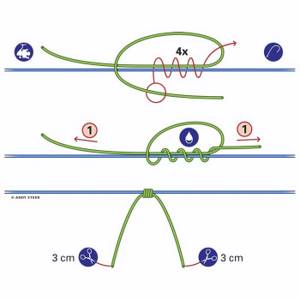
To make a marker knot on the main line, follow these steps:
- Cut a small piece of fishing line or some elastic material, 7-10 cm long
- Attach it to the main line, in the place where you want to make a marker knot
- Form a loop from one end
- Make 4 turns inside the loop with the free end
- Wet the line and tighten the knot

